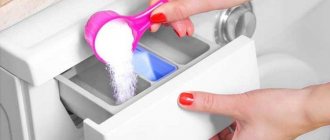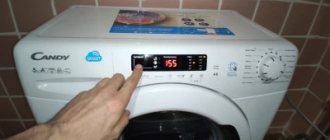Can bleach be added to the washing machine? The variety of detergents, bleaches and stain removers is pleasing, but also confusing. Which ones and when to use? Is it possible to combine them, what should I choose for hand washing, and which ones should I use in an automatic machine?
Especially many questions arise when using bleaches. I want to get a clean, white thing, but at the same time maintain its strength, not harm my health and not break the washing machine.
- Types of bleaches
- Features of use when machine washable
- Advantages and disadvantages of "Whiteness"
- Where should you pour bleach?
- Bleach with chlorine
- Washing machine cleaning
- Restoring yellowed plastic
- Expert advice
Types of bleaches
Rarely will a housewife tolerate yellowed and grayed things in her house. But color change is inevitable for white fabrics. To restore their freshness and whiteness with just one wash, you will need to use special preparations.
The times when the arsenal of bleaching products consisted only of bleach are long gone. Modern industry offers many options for chemicals. The whole variety of funds can be divided into three classes:
- oxygen bleaches;
- optical;
- chlorine-containing substances.
Washer tray compartments
Oxygen
Such drugs appeared on the market not so long ago. However, due to the powerful but gentle influence, they immediately won the trust of the housewives. The line of these products is represented by hydrogen peroxide powder, to which additional substances (fragrances, softeners) are added.
Oxygen bleaches will not ruin even the most delicate items. The only downside is the significant cost of these funds.
Optical
This type is not new at all. A substance such as blue, which was actively used in everyday life 40-50 years ago, was nothing more than an optical brightener. Absorbing the yellow color, ultramarine visually made things whiter. Modern industry offers more convenient and effective means.
But the principle of their effect is the same: to make the thing whiter using an organic dye. Optical brightener cannot clean the product or remove stains.
Expert opinion
Irina. Housewife.
Ask a Question
Its task: to create the illusion of whiteness. The more often you use such a product, the worse it will cope with the task - the fabric will simply become clogged with the substance.
Chlorine
Chlorine bleach has been around for almost 100 years. They are presented on the market in both liquid and dry forms. Their popularity is explained simply: they are effective even in cold water, remove not only yellowness and grayness, but also stains, disinfect things and are affordable. But these funds also have plenty of disadvantages.
They can only be used on a narrow range of fabrics: cotton and linen, and only white. Bleach will simply ruin other things.
The use of such products can cause allergies and other serious health problems.
Dry
Oxygen-containing powder bleaches are suitable for use in automatic washing machines. There are products that start working at a water temperature of 40C. Most require heating up to 90C, but they also cost less.
Product for colored laundry
All oxygen-containing bleaches can be used when washing colored items. It will give them freshness and brightness of colors, this will be especially noticeable on contrastingly colored things.
Do you wash your shoes in the machine?
Oh yes! No
Precautions and recommendations for working with the product
Whitening using an aggressive component is only possible if the basic rules for using the product are followed. Ignoring them can end disastrously not only for the thing being processed, but also for health.
- It is allowed to work with the drug only with a mask and gloves; it is also advisable to stock up on plastic glasses. This will prevent skin corrosion, the development of burns of mucous membranes and the occurrence of allergies.
We recommend: How to prepare antistatic agent for clothes at home?
Tip: If you place a bottle of bleach on the bottom during storage, you may have problems unscrewing the cap one day. It is better to place the container on its side, carefully closing it. Some manufacturers even began to produce their product in bottles with a round bottom, specifically forcing users to take this step.
- If during the bleaching process bleach gets on exposed skin or mucous membranes, you should immediately wash the affected area and see a specialist as soon as possible. It is prohibited to independently treat the resulting irritation or ulcers. New chemical reactions will only make things worse.
- Ingestion of the composition can cause severe poisoning, burns of the esophagus and tissue irritation, so the composition must be kept in a place inaccessible to children and pets.
- You should not try to remove stains from colored clothes using “Whiteness”. Along with the dirt, the color will come off and it will be impossible to restore it.
- You should not wash white leather, wool or silk with bleach. Delicate material, if it does not change its texture, will certainly turn yellow. No amount of stain removers or hydrogen peroxide will restore things to their original condition. “Whiteness” is best used for bleaching linen, cotton and very fine synthetics (if there are no prohibitory signs on the product label).
- “Whiteness” cannot be diluted in hot water. Such a combination of two already aggressive factors will not increase the effectiveness of the approach, but it is quite capable of reducing the strength of the fabric by thinning the fibers.
- Household chemicals should be stored in a dry, dark and fairly warm place. It is strictly forbidden to keep the bottle on the balcony in an attempt to get rid of the obsessive smell, especially in the winter months. Once frozen, the liquid almost completely loses its effectiveness.
- An open bottle should be used within six months. After this, the chemical composition of the product will noticeably change and its effectiveness will decrease. It can continue to be used, but the concentration of the composition in the water will have to be increased, and this can lead to damage to the item being bleached.
We recommend: How to quickly and efficiently clean and wash a carpet with Vanish?
All rules are easy to follow. Compliance with them guarantees the safety of textile products during processing, and the housewife – the absence of unpleasant sensations and the prevention of additional problems.
Features of use when machine washable
When using bleaches, you must follow a number of important rules:
- pour or pour the product into a specially designed compartment, the location of which is indicated in the manual;
- use chlorine-containing products only if this is permitted in the instructions for the washing machine;
- wet, not dry, items should be placed in the machine drum;
- fragile, thin ones should not be washed for more than 15 minutes;
- After washing with bleach, be sure to rinse twice.
How to bleach correctly
For lightening fabric, a washing machine is a very practical thing, since, firstly, it is convenient to bleach large amounts of fabric such as tulle curtains and bed linen, and secondly, when the temperature during washing reaches 90C, you do not come into contact with the container, so you don't risk getting burned.
Bleaching powder As we have already found out, the optimal one for use in a washing machine is oxygen bleach, in which hydrogen peroxide acts as the active ingredient. Many automatic washing machines are equipped with a special compartment for such additives in the detergent tray and even a built-in “Whitening” program. This makes the task even easier. The whitening instructions are as follows:
- First, the laundry is sorted by type of fabric. Panties, T-shirts and bodices are always bleached separately; tulle cannot be bleached together with clothes or bed linen with towels. Different types of cotton clothing can be bleached together, such as T-shirts and socks. It is absolutely forbidden to wash white things with colored ones! The selected laundry is loaded into the drum of the machine.
- Powder and bleach are poured into the detergent container into the appropriate compartments. The bleach compartment, if present, is usually indicated by a triangle, and the powder compartment by the Roman numeral two.
- All that remains is to choose the washing mode based on what fabric the items are made of. For tulle curtains, silk blouses or sheets, you should only select the “Delicate Fabrics” mode. For cotton bed linen, clothing and towels, choose a mode for dense fabrics with a temperature of 60-90. First, it is worth studying the information on the product labels, which indicate the washing temperature allowed for a given item.
- Start the program and wait for the wash to finish.
Washing white clothes.
[custom_ads_shortcode2]
Advantages and disadvantages of "Whiteness"
White
“Whiteness”, due to its versatility, is as popular as it was decades ago. This tool really has many advantages:
- works in both hot and cold water;
- used for disinfection, whitening, stain removal;
- quickly dissolves in water;
- It is characterized by economical use and low price.
“Whiteness” is a product that has been proven over the years and can be used to clean a washing machine. But this also comes with many disadvantages:
- An open container with a substance must be used quickly. After 2-3 months, the product will lose its effect.
- it has a characteristic pungent odor, which is not pleasant to everyone;
- the product may cause severe allergic reactions;
- do not use on delicate fabrics;
- in automatic machines, the product must be used very carefully, and the instructions must contain a direct indication of the possibility of using chlorine-containing bleaches.
Do you wash by hand?
Oh yes! No
Description of the product
Fragrances may be added to the bleach to improve the smell. Despite the large selection of new whitening products, “Whiteness” is on every housewife’s shelf. With its help, many everyday problems are solved.
Properties
The scope of application of the product is wide.
List of main areas of use:
- whitening,
- stain removal,
- dishwashing,
- disinfection of premises,
- cleaning plumbing.
Price
“Whiteness” is included in the category of cheap products. The cost of a liter bottle depends on the place of production and can vary from 14 to 60 rubles.
Where should you pour bleach?
A modern SMA has two compartments: for detergent and for bleach. Often manufacturers also make a third compartment - rinse aid is poured into it. In order for the washing quality to be high, you need to fill them correctly.
The smallest compartment in volume is intended for rinse aids. Powder is poured into the middle one during the “soaking” and “pre-wash” programs.
The largest one contains powder, stain removers and bleaches.
tray compartments
Factors causing pollution
Factors contributing to contamination of the washing machine are:
- Washing old clothes or clothes. Fabric lint falls off the items being washed and ends up in the drainage system. As a result, the filter becomes clogged and the drain stops working. You'll have to clean it up;
- Using too hard water for washing leads to the appearance of scale on the internal components and parts of the machine;
- Neglect of cleaning the external and internal surfaces of the washing machine. Lack of ventilation after each wash and constant moisture in the drum, detergent drawer and under the rubber sealing collar;
- The use of low-quality powders, rinses and conditioners, which leads to the appearance of soap deposits on the inner walls of the drum, which leads to rotting and the appearance of a musty smell.
Washing machine repair and maintenance specialists recommend following some rules to help avoid breakdowns:
- Try not to wash at temperatures above 60 degrees. This temperature is quite enough to remove even the toughest stains and dirt;
- Use high-quality powders from well-known manufacturers;
- Purify and soften the water used for washing by installing special magnetic filters and water softeners.
Sources:
- chistodar.com
- remontcma.ru
- 1stiralnaya.ru
- boilervdom.ru
Washing machine cleaning
Washing machines often emit an unpleasant odor. It is caused by various reasons, but it is necessary to get rid of it.
Otherwise, clothes washed in such a machine will also smell musty.
To get rid of the smell of dampness you need:
- add powder and set the mode to 95C. After the end of the program, thoroughly wipe the drum, seal and ventilate;
- Pour at least 1 liter of “Whiteness” into the main wash compartment and set the temperature to maximum. When the machine body becomes warm, set it to pause. Leave for 1-2 hours, then drain the water. Set the “rinse” mode twice. The first time, add food vinegar to the air conditioner compartment; the second time, do not add anything.
Are you using citric acid?
Oh yes! No
Why do things spoil?
In order for the laundry to remain unharmed after treatment with “Whiteness”, it is not enough to know where to pour the product, you also need to know how to use it correctly. In case of violation of the rules:
- wear and tear of things accelerates;
- materials become thinner and worn out;
- things tear, holes appear on them.
Experts do not recommend using bleaches in SMA at all. But experienced people assure: it’s all about the technology of use and the correct dosage. If you do everything correctly, you can get rid of any stains, whiten fabrics and not damage the machine at all.
Restoring yellowed plastic
Over time, most white plastic cutlery will turn yellow. And the washing machine body is no exception. It is possible to return it to its former whiteness, and there are several ways to do this:
- Take 2 tbsp. washing powder, 2 tbsp. baking soda. Pour in 1 liter of water and stir. Apply the resulting mixture to the yellowed areas and leave for a couple of hours. Then rinse with warm water.
- Second way:
- Apply a few drops of ethanol alcohol to a cotton pad. Wipe the plastic thoroughly;
- moisten a clean rag with vinegar essence and treat the car;
- Purchase a spray to restore the whiteness of plastic surfaces from a specialized auto store.











